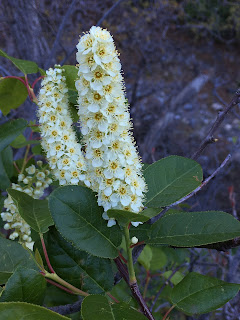 |
| Prunus virginiana spring flowers |
 |
| Prunus virginiana fall berries |
Fall is the time for berries and one of the less sought after berries is Prunus virginiana, or Chokecherry. Chokecherries are very astringent, and most of the time I try them, a single cherry will dry my entire mouth out, which makes me not want to eat any more.
However, if you wait until the cherries are very, very ripe, such as in September or later, when they are very dark red or black, and most have either fallen off, been eaten by birds, or dried up, at that time they can be fairly good. They are still a little astringent, so it takes ten or more to get the full effect, but they are also pretty good tasting, enough that I want to eat more of them. They are mildly sweet, with a good flavor, and more juicy than fleshy.
Most of the trees have only a few berries on them, but you can find some with quite a few on them, though there are usually just a few on each branch. Maybe we don't have enough bees in the desert to pollinate them all. Chokecherry trees are not very tall, and sometimes only bush-sized, so it is possible to bend down the branches to reach the higher ones, especially if you have a nice hooked stick for that purpose. When you find a tree with a good amount of fruit, they are easy to pick quickly because they grow in bunches (racemes) which allow you to strip many fruit off together.
Chokecherries can be made into a good tasting jam or jelly, if you add enough sugar, and some lemon or lime juice. The pits are not very hard and break up in an auger juice press, but I didn't want to risk abusing my juicer with a lot of hard pit fragments, so I separated the pits manually after boiling the fruit to soften them (one could also press them through a screen), and then ran the fruit through the juicer to separate most of the solids. I started with one part sugar and two parts cherry juice, and 1 tablespoon each of lemon a lime juice. After tasting, I added a little more sugar, because it seemed to need it. Sugar-only jelly recipes recommended boiling until it reached 210°F (based on my altitude), but it turned out too thick (it was like honey). Those recipes are mostly based on extracting the juice with a steamer instead of a juice press, so they get less of the fruit's natural pectin that way. It would have been better to test the thickness of the mixture occasionally until it was right, instead of trusting the temperature alone.
The always entertaining Sam Thayer talks about them in "The Forager's Harvest", where he says his favorite way to eat them is dried into fruit leather. He also tells an interesting story about how the Indians would crush the pits up with the fruit before drying. The pits contains some cyanide compounds, but these break down in the drying and/or fermenting process.
Identifying chokecherry bushes in the spring is easy, because of the long racemes full of white flowers. The berries also grow in racemes (a single central stem with flowers or berries branching off one at a time) and this is one way to distinguish chokecherries from other kinds of cherries. Once the flowers are gone, look for racemes of ripening berries. You can also look at the base of the leaf for two small dots or glands. These glands are common in cherries, and not so much in other Prunus species, such as plums, almonds, apricots and peaches. I have seen them on hawthorn leaves, though.